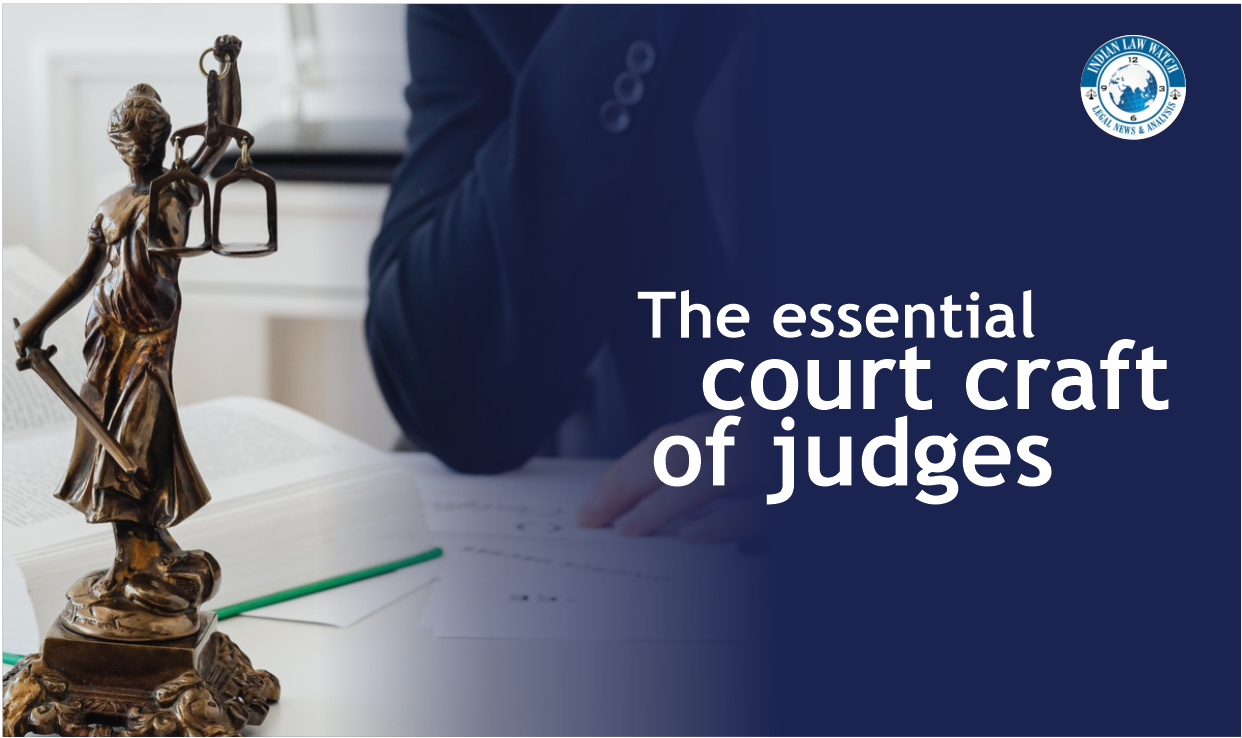
The court craft and the court management go together. A judge must be able to extract the maximum from the members of the Bar.
It was during the month of May, 2022, two judges of the top court retired. The Supreme Court Bar Association on both occasions organized farewell events. It was on May 9, 2022 that Justice Vineet Saran was given a warm sendoff. Justice Saran, in his address, said the court craft was necessary not only for the lawyers but for the judges also. Sharing his own court craft, he said he would sometimes appear to be angry during the hearings when in reality, he was not. May I say, this was a meaningful court craft. I asked myself, why should a judge appear to be angry? Many a time, a judge does not like, how the lawyer is conducting his case. May be, the judge feels he is wasting the time of the court. May be that he is repeating or digressing. How to stop the lawyer? If you politely tell him, it may not make any difference. In such a situation, a judge shows his annoyance., not anger. This is court craft. It achieves the desired result. Shakespeare has said, he is a fool who cannot get angry. He is wise who will not. The lawyer must not think that he can take the judge for a ride. The annoyance of the judge in such a situation is desirable. It does not amount to losing temper. Also not disturbing the cordial environment of the court. It is only to make the lawyer realize that he must assist the court appropriately. But if a lawyer feel he does not need to take note of the annoyance when the judge is actually not angry, the judge could really get angry. Therefore, this must be avoided.
The second event took place on May 20 to bid farewell to Justice L.Nageswara Rao. He was the seventh lawyer directly appointed to the Supreme Court on May 13, 2016. During this event, senior advocate Pardeep Rai revealed that Justice Rao has starred as a policeman in a Hindi film: Kanoon Apna Apna alongwith Sanjay Dutt and Anupam Kher among others. While speaking on this occasion, Justice Rao shared that he was in theatre in college. His cousin was a director. So, he got a short role in a movie. That was all. He never wanted to become an actor. Lawyers act in court, he added. Judges also do. Whenever there is heat between the lawyers, judges try to bring truce. He went on to say: ‘acting is part of the profession’. This is also court craft. The task of a judge is difficult. He has to find the Truth and do complete justice. My experience at the Bar tells me, it is not all that easy to read the mind of the judge. While arguing, I felt that the judge was totally against me. He was countering every argument of mine despite my best effort to be persuasive, rational and reasoned. When the counsel on the other side started arguing, the countered him tooth and nail. In fact, I so felt that the judge was only acting when I was arguing. Ultimately, my petition was allowed. This was real court craft on the part of the judge.
The judge must be able to extract the best from both the lawyer without unfolding his mind till the end so that ultimately, the truth prevails. Justice is done. If in the beginning of the case itself, the judge gives his mind, he would fail to get the best possible assistance from the Bar.
Justice M.C.Chagla was elevated as a judge of Bombay High Court on August 4, 1941. He became the first Indian Chief Justice of Bombay High Court on August 15, 1947. He resigned as Chief Justice in September, 1958 to take over as India’s Ambassador to Washington. Justice Chagla was quick in perception, broad in vision., fresh in approach. He was unique. He would never read petitions beforehand. He never liked the idea of forming impression/opinion about the cases. He was a blend of courtesy and speed. His court craft was, he would allow the advocate to complete his arguments without interruption. He would rephrase the arguments in words better than the counsel. He would ask, if that was the point that he was making. This would leave no scope for repetition. No further elaboration. Extremely courteous. Equally firm. On completion of arguments, he would dictate the judgment in the open court. Even in the most complex cases. In his 17 years of judicial journey in Bombay High Court, he reserved judgment only in two cases. There was difference of opinion. The judgment was reserved only to bring unanimity in their opinion. He was such a fine mix of court craft. With his court craft, he made huge contribution. He expired on February 9, 1981. His court was a temple of justice for the litigant. An academy of judicial education for judges.
Justice S.S.Sandhawalia was a judge of Punjab & Haryana High Court from 1968 to 1977 and Chief Justice from 1978 to 1983. Thereafter, he remained Chief Justice of Patna High Court from 1983 to 1987. What a beautiful judicial journey spread over almost two decades. When I joined the Bar, I was told he was a most polished and cultured judge. Even when he dismissed a petition (which he did more often), he would not let you feel bad. A smile on his face, he would say, I wish I could accept your argument. May be you would be able to persuade me in your next matter. I assure you, you have done your very best. Sorry. Resultantly, you would come out of the court as if nothing had happened. You may have lost a case involving high stakes. This was his court craft. I joined the Bar in early 1991. I never had the opportunity of appearing before him. I wanted to experience Sandhawalia flavor. After retirement, he became President of Haryana Consumer Commission. I got the opportunity. I argued before him. I was heard without interruption. I was told, Dr. Gupta, we used to hear you in Panjab University. What a pleasure to have you before us. Of course, with a smile on his face.
I thought my matter was going to be dismissed. It was allowed. I bowed and came out. It was a pleasant experience. What court craft! He would also write his judgments beautifully and in a manner most lucid. Judges with such court craft are rare.
The court craft and the court management go together.
A judge must be able to extract the maximum from the members of the Bar. This helps both ways. Good assistance from the Bar means good judgments from the Bench. Courtesy and patience are integral to court craft. Courteous demeanor should be part of personality of a judge. Sobriety in behavior is the hallmark of a judge. It is essential to sustain public confidence in the institution of judiciary. The court craft is a gift of a judge. From senior judges to younger judges. May I also say, it begins from the Trial Court and moves upwards. It is judicial creativity.
Written by Dr Balram Gupta
(Author of My Journey with Law and Justice, Prof (Dr) Balram Gupta is Professor Emeritus, Senior Advocate, and Director (Academics) at Chandigarh Judicial Academy.)
Source: The Indian Express





